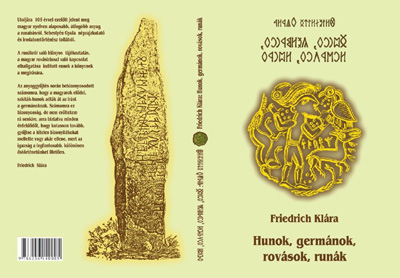|
|
|
Huns, Germans, Rovás and Runes
|
|
|
Huns, Germans, Rovás and Runes |
A
Book about the Connections between the ancient Hungarian writing (Rovás) and
the Runes (2020)
Written
by: Klára Friedrich
I have always had a great
interest in writing systems, letters and books. I soon realized that more than
a half of the Germanic, Anglo-Saxon, Scandinavian runes are similar to those
of the ancient Hungarian letters (Rovás letters).
I also noticed that the
Hungarian and foreign representatives of the history of writing in the Hungarian
Academy of Sciences are silent about this fact. Of course, the foreign scholars
are silent, because they do not know that we, Hungarians, have an ancient writing.
If they know anything about it, their knowledge come from the Linguistics and
Historiography departments of the Hungarian Academy of Sciences. As far as they
know the Hungarians originated from the Finno-Ugrians and Turks, and their language
as well as writing also had the same origin. In contrast to this, the Hungarian
chroniclers and historians call our ancient script Scythian-Hun writing and
of course they are entirely correct.
The name of this script
in the international writing system standard Unicode: Old Hungarian.
In my opinion, the ancient
Hungarian writing is even more ancient than the Scythian-Hun age. It originates
in the written signs of the Carpathian Basin of the Stone Age. The first person
to discover this, was the Hungarian-born Zsófia Torma, the first
female archaeologist in the world (1832-1899), but many other scholars write
about these ancient signs, like Marija Gimbutas (1921-1994), the
Lithuanian-American archaeologist and Shan M. M. Winn, an American researcher.
The connection between the
Runes and the ancient Hungarian letters based on large scale similarities which
cannot be accidental. At the end of this study, I shall demonstrate the tables
of comparisons.
I have found data in the
writings of several authors about the good connection between the Huns and the
Germanic peoples, e.g. Jordanes, a Goth historian (6th century), Edward
Gibbon, an English historian (18th century) and Amadé Thierry,
a French scholar (19th century). This is also supported by familial connections
and marriages. The Hun kings, Balamber and Attila, had Germanic
wives, too. There were 13 marriages between the kings of the Hungarian House
of Árpád and family members of the Normann-Viking ruling House of Rurik.
In the famous Battle of
Catalaunum (Mauriacum) in A.D. 451, the majority of Germanic people fought in
the army of Attila, the Hun king, against the Romans.
Certain comparisons can
be found in the legends of the Huns and the Germanic peoples, e.g., the respect
for the sword, the tree that reaches to Heaven, the stag, the blood union and
the raising of the leader on a shield.
Because of the large-scale
similarities of the form of the letters, I suppose that the Scythian-Hun ancestors
of the Hungarians passed on the knowledge of writing to the Germanic peoples.
This could have taken place when large groups of Germanic people (Skirs, Goths,
Gepidas, Quads) migrated from Scandinavia to Southern Russia between the 2nd
century BC and the 2nd century AD and settled in the areas populated by Scythians.
Another possibility is that
the Scythians transmitted their writing to the Germanic peoples in the Carpathian
Basin. The Carpathian Basin was a central point for the script; the writing
symbols of the Tordos civilization, discovered by Zsófia Torma, also originated
from here. It was also here, in this area that Wulfila, the Goth bishop (310-383)
created the Gothic writing system.
A few titles from the
Table of Contents:
About the Hun-Germanic connections
About the runic-script - its origin, age, variants and rules…
The Germanic numbers
The name of Attila, the Hun king and the Rune called Othila
Runic inscriptions found in the Carpathian Basin and their connection with the Hungarians:
- Aquincum - a runic inscribed fibula
- Bezenye - runic inscribed fibulas
- Breza - a piece of marble inscribed with runes
- Csákvár - runic inscribed fibulas
- From Debrecen to Wapno - bracteates and amulets
- In the Enns region - inscribed pottery shards
- Garbány - runic pottery shards
- Heidenheim - inscribed belt-end
- Kismarton or Kiskőrös, Hungarian runic script or runes?
- Lippó - disc with runic script
- Nagyszentmiklós - are there runes on the treasure?
- Pietroasa - neckband inscribed with runes, a present from Atilla
- Szabadbattyán - inscribed belt buckle
- Tárcsó - decoration or rune?
- Vojvodina - inscribed seal-ring
- Yarmouth - Stone inscribed with runic script
- Abbess Gerberga's inscribed casket (Brunswick casket)
- Hun letters in the book of an English scholar
- Runic seal or decorated button
Viking familial connections, Viking runes, Hungarian letters
Famous runic inscriptions: The Björketorp runestone, the Codex runicus, the Gallehus Horns, Jelling runestones and the Rök runestone
About German mythology (briefly)
Hun references in the Nibelung's song
Reading exercises of the runes
Tables concerning the history of writing and the similarities between runes and ancient Hungarian letters.
Important foreign writers
from literature:
Franz Altheim, Michael Babcock,
Rudolf Broby-Johansen, Benjamin Daniels, Klaus Düwel, Jurij Kuzmenko, Mircea
Eliade, Karl Faulmann, Johannes Friedrich, Alexander von Gleichen-Russwurm,
Arild Hauge, Elizabeth Hering, Tineke Looijenga, Theo Vennemann, Raymond Ian
Page, Andrew Robinson, Georg Stephens, Esaias Tegnér, Wimmer, L.F., Helmut Arntz,
Shan M.M. Winn…
Text translated by Margaret
Botos
|
|
|
 |
|
|
|
|
Huns, Germans, Rovás and Runes
|
|
|